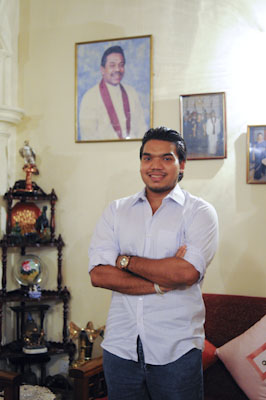Sri Lanka: Saturday night at the Rajapaksas’
You won’t find it in any Lonely Planet, but Carlton House is perhaps one of southern Sri Lanka’s best-known landmarks. From the outside it’s like a fortress but once through the imposing iron gates, up the long cobbled path and through the wide carved wooden doors it’s more like a friendly sprawling B&B, with comfortable seating, artfully placed doilies and family photographs everywhere. But don’t be fooled: this is a place where much official business is done, in amongst the clusters of sitting areas that dot the three front rooms. It is, after all, the summer home of Sri Lanka’s President Mahinda Rajapaksa.
It came to be that I was at Carlton House one Saturday night, when by rights I should have been poolside with a cocktail. But rather, I found myself perched on the edge of a sofa, my thighs sticking to the black pleather in the fan-cooled room, and craning my neck trying to see what was behind the curtain separating the public areas from the Rajapaksas’ private rooms.
It was January 2011 and I was there not to meet the president, but rather his son Namal, the MP for the nearby Hambantota region. I was writing a story for Monocle on the rise of Hambantota: currently a sleepy, under-developed town on the southern coast with little more than a cluster of municipal buildings and deep-sea fishermen. But things are a’changing, and the president wants his hometown to flourish. So Hambantota is getting reams of development money fo Sri Lanka’s second international airport, a cricket stadium, a convention centre, an expanded sea port and more. These projects have been underwritten by the Chinese, who are also providing much of the labour and expertise.
Getting an interview with Namal turned out to be relatively easy: his people agreed immediately – enormous banners of Namal with his father dot the region – however settling upon a mutually agreeable time was the difficult part. The photographer Poulomi and I had a mere three days in Hambantota, so after a bit of wrangling we finally settled on Saturday night. I’m sure Namal had better things to do, but he turned up promptly, entourage in tow, and, seating himself on a matching black pleather armchair, pleasantly answered all my questions.
Polite and enthusiastic about the plans in motion to develop Hambantota, he reeled off everything from figures on youth unemployment to detailed plans for the cricket stadium, with ease. Namal, young and solidly built, himself is a rugby player and working to widen the game’s popularity in Sri Lanka, and said that the initial plans for Hambantota were to develop it as a model sports city, full of top-end sporting facilities. (Hambantota was in the running to host the Commonwealth Games in 2018 but lost out to the only other contender, Australia’s Gold Coast.)
At the same time, however, he was breezily dismissive when I asked him whether the investment might be better used in the devastated northern or eastern regions of Sri Lanka – the former LTTE strongholds. The government has already invested heavily in those areas, he replied, listing road rebuilding and the provision of paddy as examples. But Hambantota, he said, was really, truly deserving of all the investment it was receiving: for too long it had languished, ignored, despite its handy geographic position, close to numerous tourist sites and already with features such as a port. Now, the time had come, Namal declared, for Hambantota to really shine.
As we said our goodbyes, I asked where I should send a copy of the magazine.
“Just address it to Carlton House. I’ll get it,” said Namal.
part two to come.
